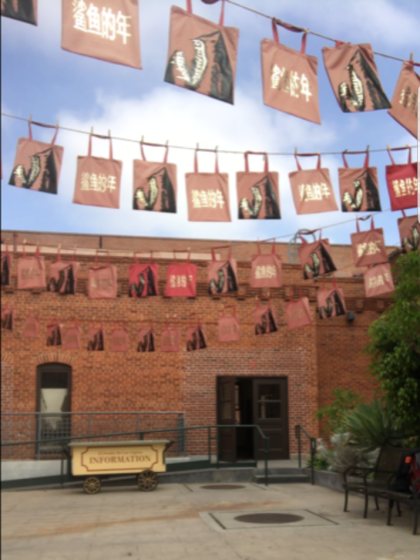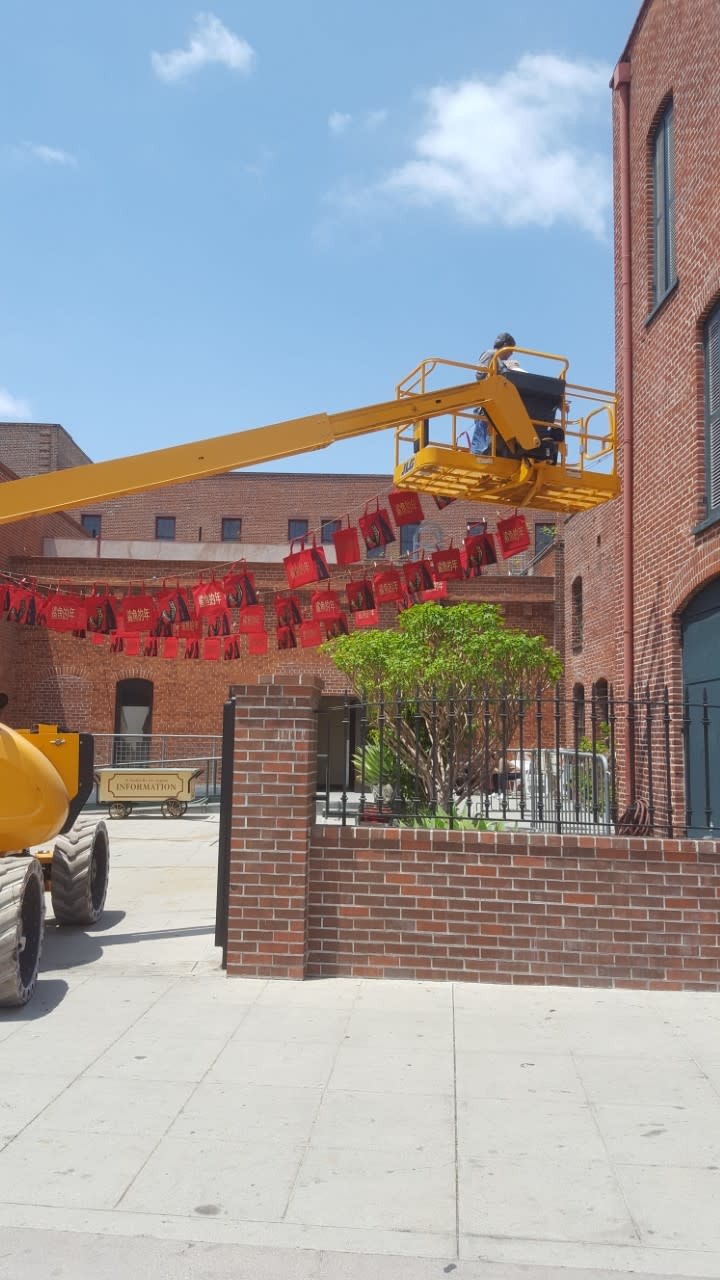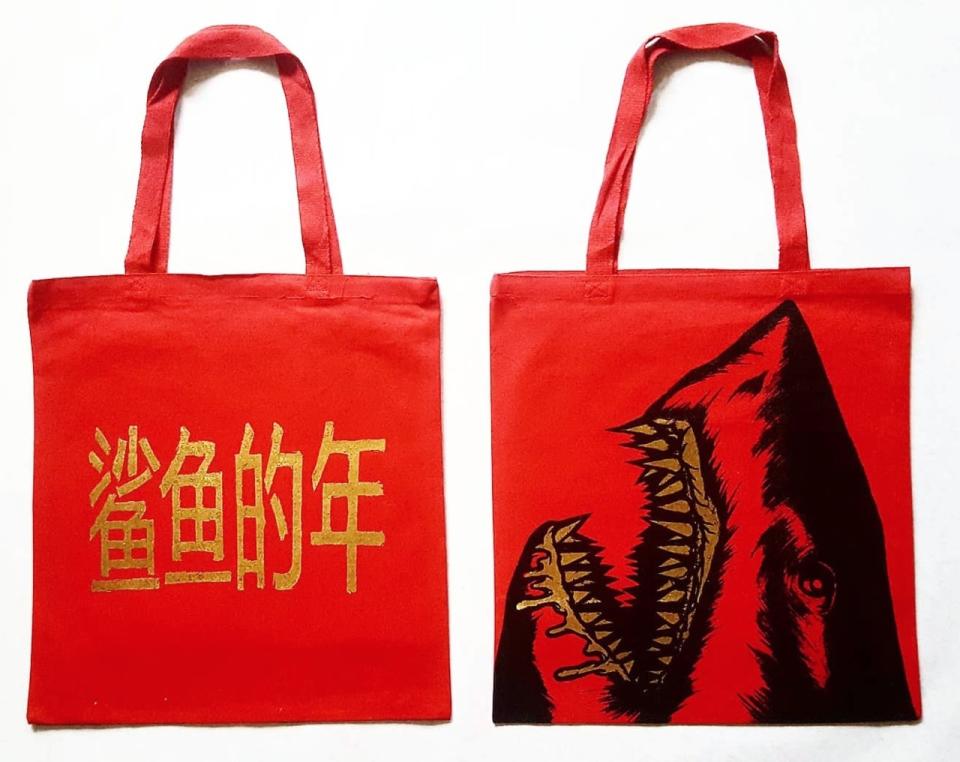Artist sues museum and city of L.A. after his work is accidentally thrown away

But is it art? That’s the question at the center of a dispute between a Los Angeles museum and an artist who showed there.
Artist David Lew, who goes by the name Shark Toof, has sued the Chinese American Museum and the city of Los Angeles, among other defendants, for throwing his work in the trash after displaying it.
Lew, who splits his time between L.A. and Detroit, was one of nine graffiti artists and muralists featured in the 2018 exhibition “Don’t Believe the Hype: L.A. Asian Americans in Hip-Hop,” which was on view at the Chinese American Museum from May to December. Lew said he contributed a site-specific installation called “Shayu De Yi Nian Lai See (Year of the Shark Red Packet)" for the museum’s courtyard. Eighty-eight empty canvas sacks were adorned with hand-applied gold leaf paint and suspended on burlap twine with wooden clothespins. It was meant to evoke the history of Chinese immigrants in the laundry business. The number eight symbolizes prosperity and good fortune in Chinese culture.
How the individual bags weathered the natural elements — the canvas fraying or the paint fading and cracking in the sun — was part of an artwork about longevity, Lew said. The bags were meant to develop individual character over time, as people do.
The museum is part of El Pueblo de Los Angeles Historical Monument, a department of the city, and is located downtown in the historic Garnier Building, the last surviving structure from L.A.’s original Chinatown. The building is owned and maintained by the city, and the museum is a city entity.
Around Dec. 7, according to the lawsuit, days before the exhibition was to end, a city maintenance crew took down the canvas bags and threw them out. According to the lawsuit, no one from the museum or El Pueblo management was there to supervise the removal of the bags. The crew may not have known the intent behind the bags and instead saw them as deteriorating objects to be discarded.
“Not being able to see these things after eight months, at the location, was gut-wrenching,” Lew said in an interview. “It’s like you’re watching the Super Bowl and they say, ‘We’re not gonna call a winner, we’ll just end it in the third quarter.’ There’s no resolution.”
Fourteen of the 88 bags were not thrown out. They had fallen down during the run of the show, Lew said, but were never reinstalled or returned to him. The lawsuit presumes the bags to be destroyed, but in response to The Times' query, the museum said the bags were put in storage.

The museum said it had not been informed by the city or El Pueblo that Lew's pieces would be removed that day but, perhaps more important, the museum said it did not see the bags as art in the first place.
Several of the bags had been promised to Lew's collectors after the show, and others were to be sold at the museum for $88 each. The museum said the bags were merchandise hanging outdoors — courtyard decor as opposed to an official art exhibit. A vendor agreement provided to The Times by Melvin N.A. Avanzado — the attorney representing Friends of the Chinese American Museum, the nonprofit that operates the museum — specified that his client would receive 20% of the sale revenue, not unlike a consignment arrangement.
The museum's executive director, Michael Truong, declined to comment and referred all inquiries to Avanzado.
“We are still reviewing the allegations," Avanzado said in an email to The Times. "However, the Friends of the Chinese American Museum did nothing wrong with respect to the tote bags that decorated the courtyard outside the museum. I look forward to proving that the claims against my client have no merit.”
Exhibition cocurator Justin Charles Hoover — who had a one-year contract at the Chinese American Museum that ended in December 2018 — said he did view the installation as art.
“We always saw David as an artist, and we saw this as an outdoor art installation,” Hoover said. “The work was always meant to weather and fade outdoors. It was meant to fall apart and be sold. Whoever took it down thought, because it was weathered, it was garbage. But I assume it was a completely innocent mistake.”
The lawsuit, filed by Les Weinstein and the law firm One llp, names the city, El Pueblo, the museum and Friends of the Chinese American Museum as defendants.
El Pueblo general manager Arturo Chavez declined to comment. Rob Wilcox, a representative from the office of City Attorney Mike Feuer, said staff would review the complaint and had no further comment.

Lew said he was not consulted about deinstallation of his work and found out the bags had been tossed when he received an email from cocurator Hoover on Dec. 12.
“We have a major issue with the bags,” Hoover wrote in the email. “The team that was tasked to bring the bags down from their lines thought they were to be disposed of. Like thrown out.”
Hoover added: "Obviously we are horrified by this."
Lew said he was speechless.
“It took months to develop the concept and measurements and diagrams and logistics," he said. "It was like a break-up or a death: You knew this one thing, and then it leaves your life in an instant, and you’re left to pick up the pieces and grieve.”
Lew, who has other work in the museum's permanent collection, showed a large painting of a shark, titled “Qinru (Trespass)," as part of the same exhibition. It was returned to him after the show, undamaged. Other artists in “Don’t Believe the Hype” included Gajin Fujita, Hueman, Kenny Kong, Defer and Erin Yoshi. Ninochka McTaggart cocurated the exhibition.
Lew declined to give a monetary value for “Shayu De Yi Nian Lai See” but said it was “priceless” to him “because it’s part of a body of work that I can’t ever, in a future retrospective setting, revisit.”
The work also has familial value, he said. Lew’s great-grandparents worked in the laundry services business after immigrating to L.A. from China in the early 1920s. He said it offended him that the bags were discarded.
Lew did not specify how much he was suing for in the lawsuit. Under the Visual Arts Rights Act, better known as VARA, the court allows for damages ranging from $750 to $30,000 per item, unless the court finds that the defendant’s action was intentional. Then damages can go up to $150,000 per item.
In addition to suing for damages, attorney’s fees and other costs related to the case, Lew is asking the court to issue an injunction preventing the city and museums under city control, such as the Italian American Museum, from taking down an exhibit without advising an artist first.
Lew’s attorney, Weinstein, represented artist Kent Twitchell, who sued the federal government and the YWCA of Greater Los Angeles, among other defendants, when his 1987 mural of artist Ed Ruscha — on a Hill Street building for nearly two decades — was whitewashed in 2006 without his permission. In 2008, Twitchell won a $1.1-million settlement.
Lew said he hopes his case draws attention to perceptions about what constitutes art, what’s worth saving and what’s disposable.
“Most people’s understanding of high art is Michelangelo,” he said. “If these were American flags, how carefully would they have been placed in a pile? But these look like something we’d eat fried rice off of — this can’t be from a master. And sadly, the bags were thrown away like dirty laundry.”
This story originally appeared in Los Angeles Times.
